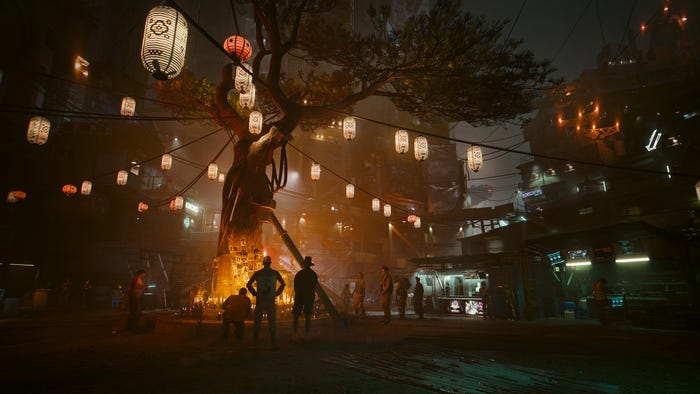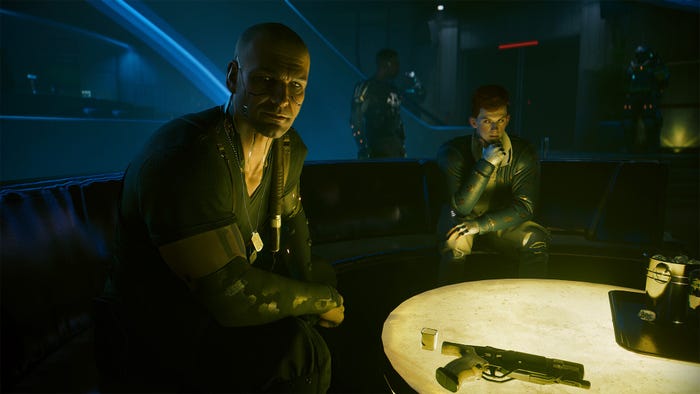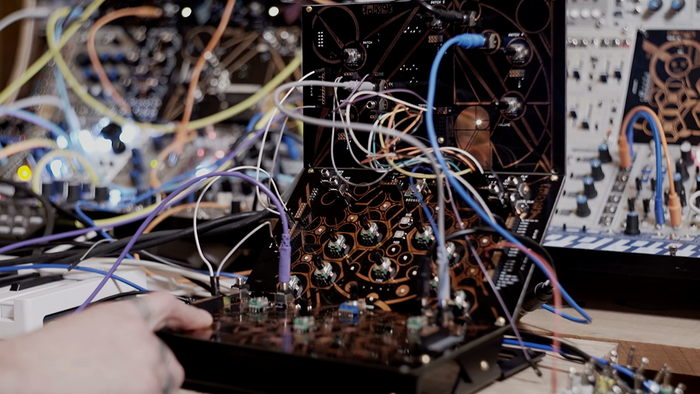Trending
Opinion: How will Project 2025 impact game developers?
The Heritage Foundation's manifesto for the possible next administration could do great harm to many, including large portions of the game development community.
Phantom Liberty composers P.T. Adamczyk and Jacek Paciorkowski explain in painstaking detail how they crafted the score for Cyberpunk 2077's acclaimed expansion.

"This time around, we were dealing with a smaller and much more focused story. Although we were making a spy-thriller story, it was essential for me to bring out colors and emotions that went beyond what you might associate with a story in this genre," explains CD Projekt Red (CDPR) senior composer P.T. Adamczyk, discussing how he began creating the soundscape for Cyberpunk 2077's blockbuster expansion pack, Phantom Liberty.
Adamczyk helped create the original score for the acclaimed expansion—which plunges protagonist V into the middle of a high-stakes tale of espionage centered around the NUSA president, netrunner Song So Mi (a.k.a. Songbird), and secret agent Solomon Reed—alongside fellow CDPR composer Jacek Paciorkowski.
During an email interview with Game Developer, Adamczyk and Paciorkowski explain that crafting the music for Phantom Liberty was less about slavishly accommodating that subtle genre shift and more about helping players connect with a new cast of characters by scoring for empathy.
"It was crucial for me to start with a piece that could play under both So Mi and Reed and give the players more context about their shared past and the unfortunate situation they found themselves in," he explains. Adamczyk notes that the tone of the game was already established thanks to his work on Cyberpunk 2077, so iterating on that score "was more about finding the right [colors] from the already existing palette."
He also says that working on the original title left him feeling more confident about scoring Phantom Liberty's more interactive scenes, given he'd already been through that process with the rest of the CDPR team. "With the help of our great Tech Music Designer, Piotr Czub, we were able to add much more dynamic music to the type of scenes which we would score with a static loop in the base game," he adds.
Breaking down his wider philosophy and workflow when it comes to scoring a huge project like Phantom Liberty—which cost CDPR around $85 million to create and market—Adamczyk says the process always starts with a general spotting session.
"We go through each quest of the game and try to understand the needs of the overall story as well as specific story beats. Once we have that understanding, we start tackling individual cues, beginning with the ones that are the most important for the story, like important dialogue cues and set pieces. This allows us to spend more time on pivotal and defining moments of the story which will later influence the neighboring cues," he continues.
"As for the writing process itself, it’s always a mystery. Obviously, having the chops from the base game can help, but it also can lead you down a beaten path, which is something you should try to avoid. With Phantom Liberty, I started with a piano motif which became the So Mi and Reed theme. I wanted to write a nocturn-esque piece which would give me the baseline underscoring their past relationship, which influenced their decisions presented in the story."
Paciorkowski echoes those remarks, noting that spotting was a "fundamental part of the process." He explains it allows him to generate initial ideas for tracks and motifs, providing him with a space to experiment and freely combine ideas while keeping individual scenes and visual cues firmly in mind.
"More often than not, I would overdo it, but that’s when playthrough sessions come in handy. It’s also when I can start the process of discarding elements that I don’t really need. For example, with 'Infiltration Compromised' I started off with an over-the-top banger, expecting that the final shape of the combat scene would be more intense. By sculpting away at the track, I managed to maintain its core vibe and make it fit better the particular intensity of the moment," he adds.
Latching onto Paciorkowski's desire to experiment, we ask the duo what it's like collaborating with the rest of the team at CDPR. Adamczyk claims they're both "very fortunate" to work in an environment where they're given almost total creative control over the musical side of the project, and notes that even when they do receive feedback, those critiques come from a "collaborative point of view rather than from a micro-managerial mindset."
Paciorkowski explains that even though the music team is given creative control, they like to reach out for feedback regularly. "If you are among like-minded people, you’re not really limited; you’re empowered to create something great. Internally, within the music team, we reach out for feedback constantly. None of us are writing in a void," he says.
"Working proactively like this always helps not only the greater collaborative process, but lets us establish smoother music narration from the start. On top of that, when it comes to the whole Phantom Liberty development team, I have never seen such a concentration of talent and raw energy on a project. When you’re among such people you tend to develop trust both ways and then magic happens."

Of course, the ability to tinker without prying eyes is a commodity worth its weight in gold, letting both Adamczyk and Paciorkowski play fast and loose with the 'rules' of electronic music to create something that warps expectations. "The biggest experiment was having the vocal trio Tulia being 'the sound of the Blackwall'. It’s not a typical mix, to have Eastern European folk singing mixed with our style of techno-inspired, hard-hitting electronic music," says Adamczyk. "But I think this contrast and the sheer power of their voices create an interesting color. It highlights the power and uncontrollable quality of the things behind the Blackwall. By being so distinct from the rest of the score, it allowed us to use those voices almost like a theme itself which created an interesting layering of meaning in many scenes."
Paciorkowski also sought to harness the "raw" nature of Adamczyk's synthesizer, which featured heavily on the score for Cyberpunk 2077, to create unexpected results without departing too much from that familiar "Cyberpunk sound" players have come to associate with the franchise. "[The synth didn't come with a] manual because the manufacturer encourages experimentation, and at times it may sound too raw, but with a little post processing and a whole lot of experimentation, anything can be created—from long airy pads and rhythm sequences to punchy and gritty bass lines," he explains.
Earlier on in our chat, Adamczyk says that creating music capable of supporting and enhancing the dialogue in Phantom Liberty was a huge consideration. Although he baked this requirement into the process from the very beginning, delivering on that promise was still a colossal challenge.
"For the most part, we don’t have traditional cutscenes in Cyberpunk 2077, so the player's actions are something we always have to consider," he explains. "That's why we bounce our cues into small segments, sometimes even 2-3 bars long, to make sure there's enough granularity in the implementation. It lets us really sync our score to the events on screen. I feel that with some of the scenes from Phantom Liberty, we topped what we did in the base game."
Discussing their personal Everest, Paciorkowski explains that while knitting together an interactive soundscape allows him to shun linearity and chart unexpected paths, it also presents an incredibly niche challenge because you have to consider a myriad variables. "On the one hand, interactive music gives me an opportunity to use what otherwise wouldn’t fit into a linear piece. I always have too many ideas. Sometimes a part of me is in a mood that’s completely opposite to the rest, or I have 2-3 levels of intensity in a segment that I cannot decide on, and the small segments we use make it possible to fit more than you could in a traditional song," he says.

"But on the other hand, this is where the challenge comes in: making sure everything works together musically, figuring out the best moments for transitions, and most importantly, making sure the music is synced to what is happening on the screen can be daunting. Fortunately our tech wizard Piotr Czub was always there to help our vision come to life."
Those weren't the only pressure points. Adamczyk explains that one of the more fiddly challenges of working on a heavy, electronic score was attempting to work around a fixed BPM reinforced by a pounding kick drum. He describes that particular hurdle as being "really difficult" to overcome.
Paciorkowski elaborates, explaining the perceived confines of the genre forced the composers to reconcile themselves with a "clash of worlds" that you might not encounter when working within a more conventional musical arena. "When scoring games or a film, a composer can use powerful weapons such as intricate details that lightly underscore the scene or a tempo/signature change to create some movement," he adds. "On the other hand, heavy electronic club music is all about a steady and heavy groove inducing a trance-like state that keeps you more or less emotionally on the same level. Figuring out how to combine these two approaches was certainly the biggest challenge for me."
Before we continue discussing the score, we ask Adamczyk and Paciorkowski to take us on a virtual tour of their studio and explain which tools were absolutely indispensable when working on Phantom Liberty. Adamczyk explains they surrounded themselves with a lot of gear made by SOMA Instruments, including their Pulsar-23—which he describes as a "spectacular drum machine" and features on a number of tracks including 'Apex Predators.'
"The Pipe [by SOMA], which is a vocal processor, allowed me to record some vocal textures myself—although I’m a terrible singer. I also used it to process Tulia's voices. You can hear the effects in the track 'Never Looking Back' or 'Gate K9,'" he says. "[I also used the SOMA] Ether, which is a wide-band receiver that translates the electromagnetic field into audio, was incredibly helpful in creating a lot of the drone sounds.
"I basically took Ether, plugged it into my portable recorder, and walked around the CDPR campus catching sounds made by everything—from monitors to air conditioning units. The results can be heard in the opening track of our score as well as in “On the Prowl”, which plays whenever V is sneaking past Barghest troops."

The Folktek Mescaline v2 looks suitably Cyberpunk
Paciorkowski's go-to synth was the Folktek Mescaline v2 he mentioned earlier, which enabled him to create an instant "Cyberpunk 2077 vibe" in a snap. He also had the opportunity to use the Motor Synth by Gamechanger Audio, which belongs to original Cyberpunk co-composer Marcin Przybyłowicz and is described as an "odd-looking electro-mechanical contraption that uses rotating discs as oscillators." Paciorkowski says scoring Phantom Liberty was his first time recording a synth in an electroacoustic way, with those rotating discs being used to create additional harmonics that he captured with his Rode NT-1A mic.
"There were quite a few dialogue scenes where I would use a slow arp from Motor Synth with an acoustic layer slightly mixed in to add harmonics. Last but not least, there’s the Shruthi One by Mutable Instruments, a DIY synth that has been with me for years now," he continues. "Most of my bass lines were created with it as well as Severins' arp that went through an Alesis delay and Analog Drive by Elektron to give it some warmth, color, and space. On the Elektron note, being a really bad drum programmer, I love using Digitakt whenever I need to create a quick drum groove to jam to on the fly."
One crucial aspect of shipping any video game is knowing when to step away. Creativity is a process of constant iteration, but that means our desire to tweak and hone in search of perfection can be debilitating if left unchecked. How do you know when to set yourself free? Adamczyk says it's about trusting your intuition.
"We play the game a lot and we check our work frequently. If a scene rubs us the wrong way, we have to make changes. But why it happens, I really don’t know. I guess, at the end of the day, we are also gamers and audience members and we just try to make things that we would enjoy ourselves," he explains.
Paciorkowski sometimes found it harder to let go, noting that even when other members of the team were happy with his cues he still felt compelled to work on them a little longer. "I would go back to them and re-iterate. Most often this would be my process—iterating on the initial idea until I feel completely satisfied with the scene," he explained. There were, however, other occasions when everything simply fell into place from the start and a piece of music would instantly mesh with the gameplay experience." Ultimately, Paciorkowski agrees that it's all about intuition—but that means it's about trusting yourself to know when something simply "feels right."
The overwhelmingly positive reception Phantom Liberty has garnered suggests that both composers—and the rest of the CDPR team—have figured out how to land on that sweet spot. By following their instincts and leaning into Phantom Liberty's more concise narrative, Adamczyk feels the team was able to imbue the score with details and layers that simply weren't present in the main game.
He says that's evidenced at the beginning of Phantom Liberty when the track 'I'm a Netrunner' kicks in, subtly teeing up the So Mi and Reed themes that will come to define those specific characters. There's another cue that keen listeners might notice in 'Just Another Weapon,' which plays when V, Songbird, and Reed first meet face to face. That sonic tidbit also underscores a pivotal moment at the ending of the game, referencing a future that has yet to pass.
"I’m proud of how all of these scenes turned out," says Adamczyk. "They all use the same thematic material and I think that creates more attachment to the characters, and therefore makes the whole gaming experience much more enjoyable."
Read more about:
FeaturesYou May Also Like